
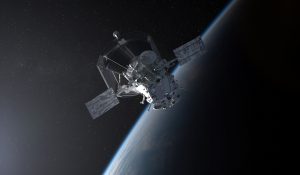
Illustration of NASA’s Parker Solar Probe leaving Earth.
Credit: NASA/Johns Hopkins APL/Steve Gribben
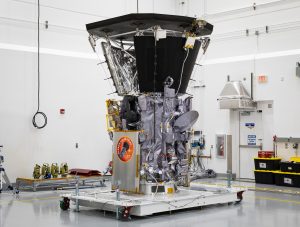
Parker Solar Probe sits in a clean room on July 6, 2018, at Astrotech Space Operations in Titusville, Florida, after the installation of its heat shield.
Credit: NASA/Johns Hopkins APL/Ed Whitman
NASA’s Parker Solar Probe is travelling towards the Sun, facing extreme heat and radiation. The goal of the mission is to give us our first sample of the Sun’s atmosphere and to repeatedly probe and observe the outer corona of the Sun. It will travel seven times closer to the Sun than any other spacecraft before, providing us with information about the corona, how solar winds accelerate and the sources of high energy solar particles. On this web page we will discuss why it is important to know more about the Sun and its properties, as well as the instruments on the Parker Solar Probe that allow scientists to discover more about the Sun. In choosing the topic of the Parker Solar Probe, we see first-hand how the probe reads the solar winds and the magnetic fields around the Sun to help us understand the weather in space.
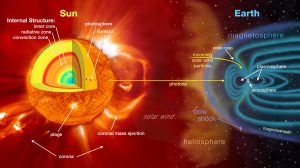
The solar wind is a stream of charged particles released from the upper atmosphere of the Sun, called the corona. This plasma mostly consists of electrons, protons and alpha particles with kinetic energy. Photo Credit: NASA


Dr Eugene Parker watching the Parker Solar Probe launch. Credit: NASA/Glenn Benson
The Parker Solar Probe is a historical mission that conducted many firsts for planetary astronomy. It is the first spacecraft to ever reach as close as it has to the sun, 6.16 million kilometers.1 The Parker Solar Probe was designed and built at the Johns Hopkins University Applied Physics Laboratory and was launched into space on August 12, 2018 for a seven-year mission.2 In the course of its mission it aims to gather and provide answers about the sun, specifically what causes solar winds.
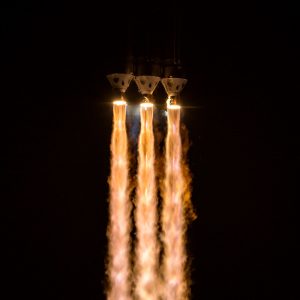
Delta Heavy IV Rockets Photo Credit: NASA/Bill Ingalls
The Parker Solar Probe is the first NASA spacecraft to be named after a living person, Dr. Eugene Newman Parker, who is a professor at the University of Chicago.3 Dr. Parker is the man responsible for the discovery of solar winds: therefore, it is only appropriate to name a solar probe that will read solar winds after this man. The Parker Solar Probe was launched at 3:31 EST on August 12, 2018 on a Delta IV Heavy which is the second largest rocket in operation and consists of three rockets strapped together. The Probe has two main instruments: the Solar Probe Analyzers and the Solar Probe Cup that can read, view and hear sounds that are surrounding the Sun. This information allows scientists to develop a greater understanding of the galaxy, specifically unanswered questions regarding the Sun which have already begun to be confirmed through the Parker Solar Probe mission.

Photo Credit: NASA/JHUAPL
The Parker Solar Probe has four main investigation elements on board that allow it to be an innovative creation. The FIELDS instrument is one that captures the scale and shape of electric and magnetic fields in the Sun’s atmosphere.4 FIELDS measure the waves and turbulence in the inner heliosphere, as well as the electric field around the spacecraft with five antennas.5 The Wide-Field Imager, referred to as WISPR, for the Parker Solar Probe is the only imaging instrument aboard, and it investigates the large structure of the corona and solar winds.6 The WISPR is an important aspect of the Parker Solar Probe as it captures the images of structures that eject from the Sun, linking what happens in the coronal structure to the details being captured in the near-Sun environment. The Solar Wind Electrons Alphas and Protons, or SWEAP as it is commonly referred to, collects observations using the Solar Probe Cup (SPC) and the Solar Probe Analyzers (SPAN).7 Through these two instruments, the SWEAP is able to count the particles in the solar wind, as well as measure the velocity, density, and temperature of them. This helps aid us in understanding solar winds, as well as coronal plasma. The Integrated Science Investigation of the Sun, also known as ISOIS (pronounced “ee-sis”), is used to measure particles across a wide range of energies by using two instruments.8 Through the two instruments on the ISOIS, the EPI-Lo and EPI-Hi, we can understand aspects of particles’ lifecycles, such as where they are from, how they grew to be accelerated and how they move through the Sun.
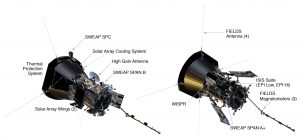
Photo Credit: NASA/JHUAPL
Launch Photos
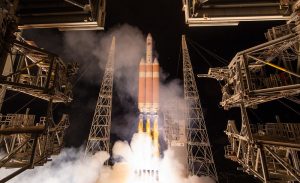
Photo Credit: (NASA/Bill Ingalls)
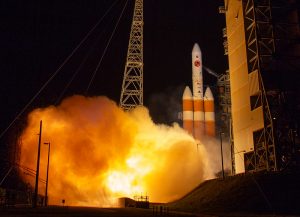
The United Launch Alliance Delta IV Heavy rocket launches NASA’s Parker Solar Probe to touch the Sun, Sunday, Aug. 12, 2018 from Launch Complex 37 at Cape Canaveral Air Force Station, Florida. Photo Credit: (NASA/Bill Ingalls)

|
Video : Top-down view of Switchback Magnetic Fields. Parker indicated that the solar magnetic field embedded in the solar wind flips in the direction. These reversals — dubbed “switchbacks” — last anywhere from a few seconds to several minutes as they flow over Parker Solar Probe. During a switchback, the magnetic field whips back on itself until it is pointed almost directly back at the Sun. Credit: NASA Goddard/CIL/Adriana Manrique Gutierrez |
The Parker Solar Probe has already made numerous discoveries in the early half of its mission. Since it can get so close to the Sun, it saw the first signs of the zone around the Sun where cosmic dust disappears, as well as “switchbacks” in the solar wind flowing off the surface of the Sun.14 Due to these discoveries, scientists have said that the current theories of the corona and solar wind will dramatically change as this gives us new information. In addition to new information about the corona and solar winds, the Parker Solar Probe has detected remnants from the Sun that are being hurled into space, drastically changing the organization of the flows of solar winds and the magnetic field.15 This will result in a dramatic change in the present theories about how the corona and solar winds are being heated. The Parker Solar Probe has also determined that the Sun is magnetically active as it unleashes powerful bursts of light and has particles moving almost at the speed of light. In particular, one event that the Parker Solar Probe identified has gained the attention of scientists. There are flips in the direction of the magnetic field that flow out from the Sun, embedded in the solar winds.16 These reversals, which have been commonly referred to as “switchbacks” will last anywhere from a few seconds to several minutes as the magnetic field whips back on itself until it is positioned almost directly at the Sun.17 This gives us new information about solar winds and how they work, allowing us to understand the life cycle of stars or formation of planets, as well as understand the effects they have on Earth.
The Parker Solar Probe instruments have been useful in unveiling new information about the Sun and the solar winds. In particular, the solar wind instrument found rotation more than 20 million miles from the Sun, and noticed that as the Probe got closer that the speed of the rotation of solar winds increased.18 The instruments on board have also measured never-before-seen energetic particle events that are so minuscule that all traces of them are lost before they reach the Earth.19 The measurements have also gifted us with a new perspective on two types of space weather events: energetic particle storms and coronal mass ejections.20 Another important factor that the instruments have discovered is the unprecedented detail on coronal mass ejections which are massive clouds of solar material that the Sun sends out into the solar system.21 These mass ejections can trigger a number of effects on Earth, including sparking auroras to induce electric currents that can damage power grids and pipelines. In understanding how the Sun and its solar material affect our life on Earth we can better our current technology to protect it from possible damages from outside forces.
|
Switchback Closeup Parker indicated that the solar magnetic field embedded in the solar wind flips in the direction. These reversals — dubbed “switchbacks” — last anywhere from a few seconds to several minutes as they flow over Parker Solar Probe. During a switchback, the magnetic field whips back on itself until it is pointed almost directly back at the Sun. The spacecraft’s approximate location is represented as a dot icon. Credit: NASA Goddard/CIL/Adriana Manrique Gutierrez |
Images Captured by the Parker Solar Probe
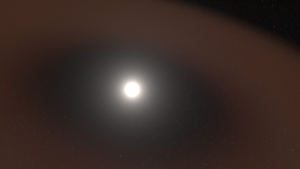
Parker Solar Probe saw cosmic dust (illustrated here) — scattered throughout our solar system — begin to thin out close to the Sun, supporting the idea of a long-theorized dust-free zone near the Sun. Credits: NASA’s Goddard Space Flight Center/Scott Wiessinger
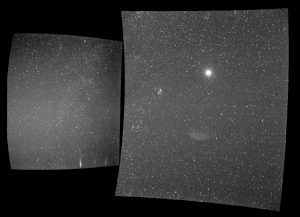
An image of the Earth taken by the Parker Solar Probe as it hurtles toward its first Venus flybyNASA/Naval

Parker Solar Probe has made new observations of energetic particles — like those seen here impacting a detector on ESA and NASA’s Solar and Heliospheric Observatory — which will help scientists better understand how these events are accelerated.
Credits: ESA/NASA/SOHO

Data from the Wide-field Imager for Solar Probe (WISPR) instrument on board Parker Solar Probe captured during the spacecraft’s first solar encounter in November 2018. Credit: NASA/Naval Research Laboratory/Parker Solar Probe

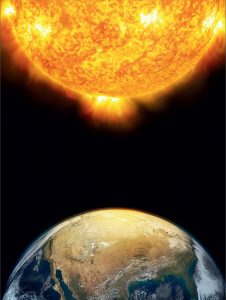
Credit: Shutterstock
Solar radiation is the energy that is emitted from the sun due to a nuclear fusion reaction that creates an electromagnetic energy. Solar radiation provides the heat, light and energy that is required for living organisms to survive, without it the earth temperature would be anywhere between absolute zero of minus 273 degrees Celsius. There are three main types of solar radiation, infrared, visible and ultraviolet. Infrared light makes up 49.4% of the light that reaches the earth’s surface. It is absorbed by water and carbon dioxide molecules and converted to heat energy which is responsible for warming earth’s surface. Infrared light has longer wavelengths than other types, so it is more easily reflected which allows the transfer of heat between the earth’s surface, water and air. Visible light provides 42.3% and is defined as light that can be visible to the human eye. Visible light colors are determined by their wavelengths. A longer wavelength appears red and shorter ones appear a blue or violet color. When visible light reaches the earth surface it is either absorbed or reflected by objects which produce different colors. The color that is reflected by the surface is what creates the color, it depends on the depth in which the wavelength is absorbed. If all the colors are reflected, then the object appears white. Ultraviolet radiation makes up 8.3% of the total solar radiation. There are three types of ultraviolet radiations distinguished by their wavelengths.12 UV-C has the shortest wavelength from 100 – 280nm. The shorter the wavelength the more damage it can cause to organisms. Fortunately, most short-wave radiation is absorbed by the ozone and only a small percent reaches the surface of the earth. UV-B has the second longest wavelength at 280 – 320 nm and is only partially absorbed by the earth’s atmosphere. This is the type of radiation that can cause skin cancer and disrupt photosynthesis in plants. UV-A has the longest wavelength ranging between 320 – 400 nm and is not absorbed at all. This is the type that causes sunburns in humans and can penetrate water deeper than both UV-B and UV-C. It can also decrease photosynthesis in plants by up to 70% by decreasing the transport of electrons.

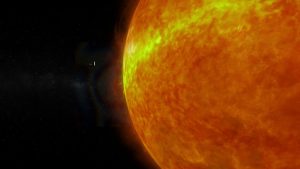
Swing By Of The Sun – Close-up
Credit: NASA/JHUAPL
The corona is the outer layer of the sun which is only seen during a total solar eclipse, as the sun is so bright that makes it difficult to see, and it is more than a million degrees Celsius – so hot that it escapes the Sun’s gravity.9 The solar winds then leave from the corona to the open magnetic field lines, and that is how it is able to get so far away from the Sun, by traveling onto the large, long lines. The corona is what produces the sun’s solar winds, its temperature is more than a million degrees Celsius, so high that the sun’s gravity cannot contain it and the gasses are emitted at a high velocity. Skylab took X-ray images of the Sun’s corona in 1973 which showed the solar winds spewing from dark coronal holes, which are comparatively cooler regions of the Sun. There has been a long, ongoing debate among scientists about the origins of the corona as well, which mostly hinges on the distinction of a closed or open corona. The closed corona regions of the Sun are where its magnetic field lines are closed and connected to the surface at both ends. When you see bright streamers or loops, that is an example of a closed corona. The open corona refers to regions where the magnetic field lines anchor to the Sun at only one end and stretching out onto space at the other end.10

|
Solar Magnetic Field Exactly where the solar wind transitions from a rotational flow to a perfectly radial flow has implications for how the Sun sheds energy. Parker located a transition region in the solar wind’s flow. Finding that point may help us better understand the lifecycle of other stars or the formation of protoplanetary disks, the dense disks of gas and dust around young stars that eventually coalesce into planets. The spacecraft’s approximate location is represented as a dot icon. Credit: NASA Goddard/CIL/Jonathan North |
Solar winds fill our entire solar system. When they come into contact with astronauts, they are exposed to radiation, they interfere with electronics pertaining to satellites, and also disrupt communications that use GPS and radio waves. The Parker Solar Probe samples these solar particles and magnetic waves in an effort to understand solar winds further, as the more we can understand solar winds the more we can do to mitigate the problems associated with them.13 Scientists have been debating on solar winds for decades on their origins and acceleration mechanisms, but there was never a question on how important it is to learn more about them and that understanding how they work would be of great importance to science. Thanks to NASA’s Ulysses mission which launched in 1990, we now know that during periods of minimum solar activity the Sun’s solar winds are confined to the equator of the Sun, which is right where the Parker Solar Probe will fly. Without the data collected from past missions, we may not know the importance of having the Parker Solar Probe being able to fly so near the equator of the sun.

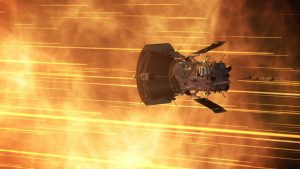
Artist conception of the Parker Solar Probe in a stream of solar particles. Credit: NASA
Solar Energy Particles (SEPs) are particles that come from the sun travelling at 250 to 750 kilometers per second, but the fastest particles can reach the speed of light. They are made up of protons, electrons and heavy ions with high amounts of energy and come from two major events. They can come from either the energy at a solar flare site or from the shock waves created from a Coronal Mass Ejection. It is important to understand SEPs because when they reach high speeds, they can endanger life in outer space. They accelerate to energies of several tens of MeV within 5–10 solar radii (5% of the Sun–Earth distance) which means in some cases they can reach the earth in a matter of minutes. Dr. Mihir Desai, a mission co-investigator on the Integrated Science Investigation of the Sun stated that “Our main goal is to determine the acceleration mechanisms that create and transport dangerous high-energy particles from the solar atmosphere into the solar system, including the near-Earth environment.”11 The Parker Solar Probe is travelling closer to the sun than any other probe and is looking to answer questions like how to protect astronauts and their equipment against the radiation that is created from solar events.
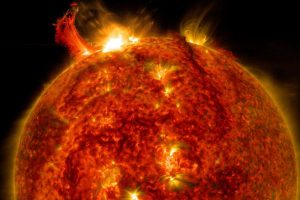
A solar flare is an intense burst of radiation coming from the release of magnetic energy associated with sunspots. Solar Flare NASA/SDO
| Coronal mass ejections are hot spews of plasma erupting from the sun. Video Credit: NASA (simulation) |
While studying the Parker Solar Probe the data and findings discovered that a concept like solar winds can be proven a reality if you can gain close enough access. The Parker Solar Probe was the first spacecraft to reach as close as it has to the sun, 6.16 million kilometers, and has resulted in new findings past its intentions to read solar winds and magnetic fields around the sun. The idea was to get a better understanding of space weather and with a greater in-depth understanding using the instruments placed on the probe. However, the probe was able to create new discoveries already within its first year of its mission by already providing information on switchbacks and other novel discoveries. This new information regarding solar winds creates a better understanding of space weather. These many discoveries have and will continue to educate scientists on outside forces like space weather that affect our life on Earth. The Parker Solar Probe has created a better understanding of solar radiation, the corona of the sun, solar winds, and high energy particles in the beginning stages of its seven-year mission and still has less than six years to gain closer and closer access to the sun. The Parker Solar Probe will continue to provide new information that will allow the science community to make sense of the unknown.